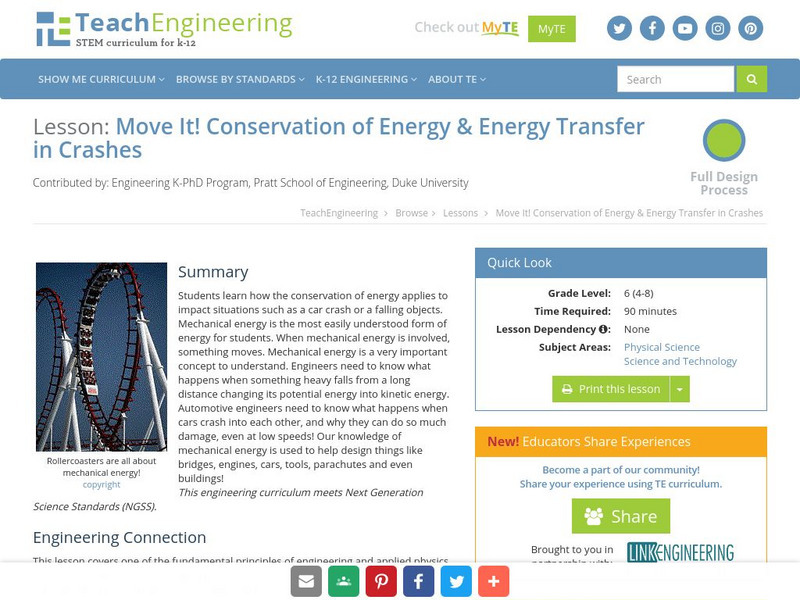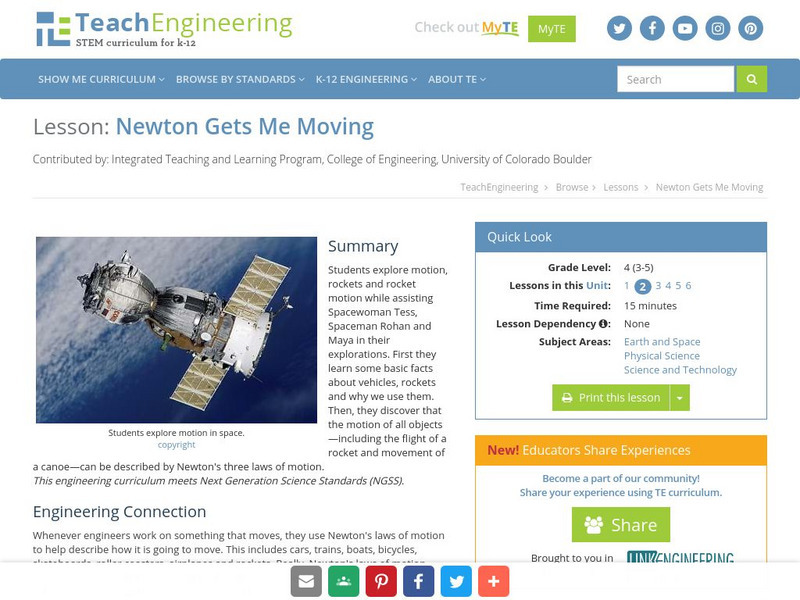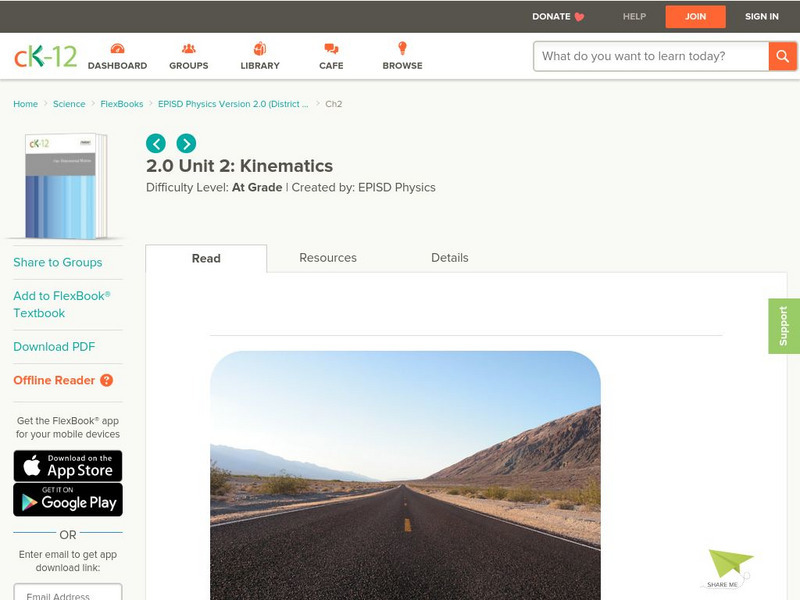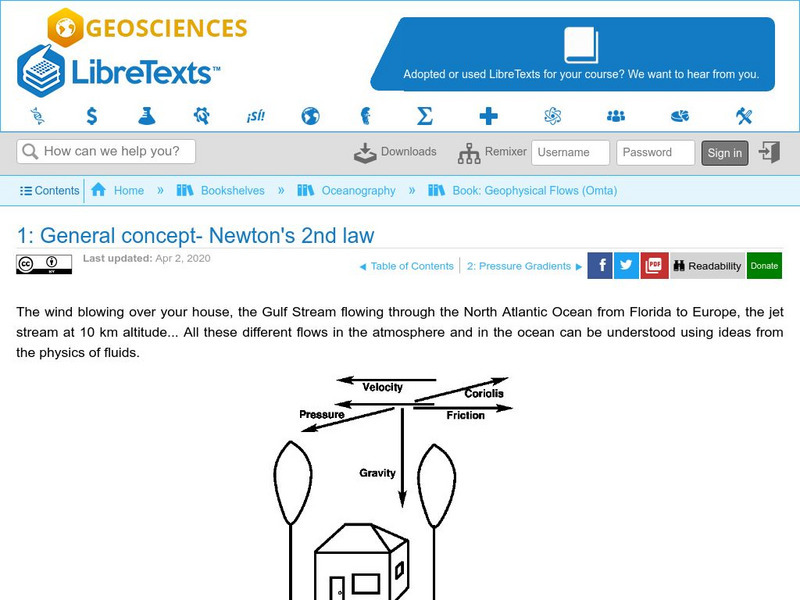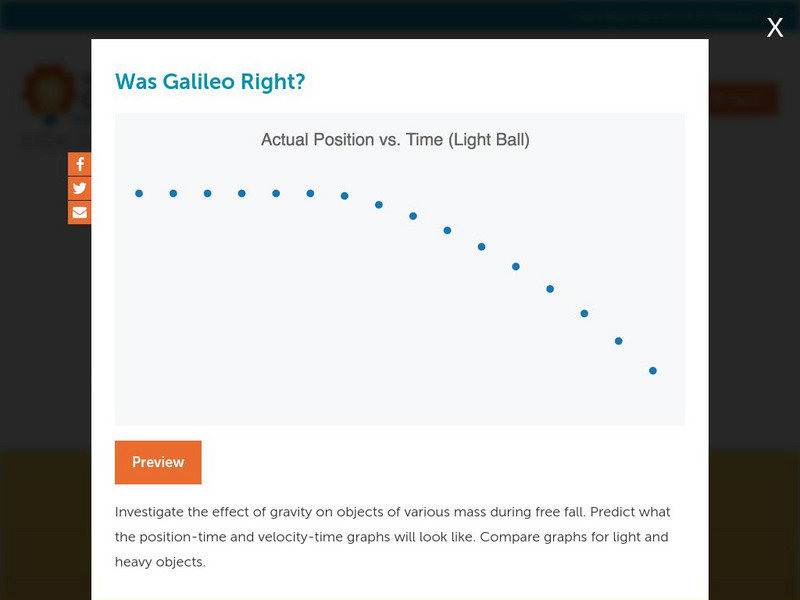PBS
Pbs Learning Media: Virtual Car: Velocity and Acceleration
Take control of a virtual car and learn how vectors are used to represent velocity and acceleration in this interactive activity developed for Teachers' Domain.
Georgia Department of Education
Ga Virtual Learning: Ap Physics 1: Work, Energy, and Power
The mathematical model for the relationships between work and energy serves to model physical problems and, more importantly, predict natural and man-made phenomena. Students discover the relationships which serve as a powerful...
Ducksters
Ducksters: Physics for Kids: Acceleration
Kids learn about acceleration in the science of physics and the laws of motion including units and measurement. How to calculate it from the change in velocity over the change in time.
PBS
Pbs Learning Media: Rocket Sled
Explore the relationship between thrust, drag, friction, weight, and acceleration in this interactive simulation and see if you can make the sled stop on a particular rock
TeachEngineering
Teach Engineering: Action Reaction! Rocket
Students construct a rocket from a balloon propelled along a guide string. They use this model to learn about Newton's three laws of motion, examining the effect of different forces on the motion of the rocket.
TeachEngineering
Teach Engineering: Move It!
Mechanical energy is the most easily understood form of energy for students. When there is mechanical energy involved, something moves. Mechanical energy is a very important concept to understand. Engineers need to know what happens when...
PBS
Pbs Learning Media: How Big Is the Universe?
In this media-rich essay from the NOVA Web site, astronomer Brent Tully of the University of Hawaii walks you through the latest scientific theories about the size of the universe.
Physics Classroom
The Physics Classroom: Newton's Second Law of Motion
Learn more about finding acceleration through the practices found in this lesson. "The process of determining the acceleration of an object demands that the mass and the net force are known." Check out this comprehensive site.
TeachEngineering
Teach Engineering: How Do Things Fall?
Students learn that it is incorrect to believe that heavier objects fall faster than lighter objects. By close observation of falling objects, they see that it is the amount of air resistance, not the weight of an object, which...
TeachEngineering
Teach Engineering: Physics Tug of War
In this activity, students will learn about Newton's 2nd Law of Motion. They will learn that the force required to move a book is proportional to the weight of the book. Engineers use this relationship to determine how much force they...
TeachEngineering
Teach Engineering: Newton Gets Me Moving
In this instructional activity, students will explore motion, rockets and rocket motion while assisting Spacewoman Tess, Spaceman Rohan and Maya in their explorations. They will first learn some basic facts about vehicles, rockets and...
TeachEngineering
Teach Engineering: The Big Mo
Momentum is not only a physical principle; it is a psychological phenomenon. Students learn how the "Big Mo" of the bandwagon effect contributes to the development of fads and manias, and how modern technology and mass media accelerate...
University of Colorado
University of Colorado: Ph Et Interactive Simulations: Ladybug Motion 2 D
Learn about position, velocity, and acceleration vectors by moving the ladybug. Set the position, velocity, or acceleration, and see how the vectors change.
Texas Education Agency
Texas Gateway: Objects in Motion
This resource provides flexible alternate or additional learning activities for students learning about the concepts of distance, speed, and acceleration.
PBS
Nova: Missing in Mi G Alley: All About G Forces
Students learn about G forces. The resource discusses gravity forces, fainting in the air, acceleration, and zero G?s.
CK-12 Foundation
Ck 12: Episd: Physics: Kinematics
[Free Registration/Login may be required to access all resource tools.] An online chapter focused on motion and the shapes it takes. Topics range from speed and velocity to acceleration and free fall. Find detailed visuals, learning...
Bill Nye
Bill Nye: Falling for Science
Try this at-home science experiment to learn about acceleration due to gravity.
Other
Frequently Used Terms in Gifted Education
Here are definition for several terms parents of gifted children should be familiar with as they research the educational options and school programs for gifted youth. Terms include "accelerated learning," "advanced placement," "cluster...
TeachEngineering
Teach Engineering: Car Collision Testing & Tradeoffs: Don't Crack Humpty
Student groups are provided with a generic car base on which to design a device/enclosure to protect an egg as it rolls down a ramp at increasing slopes. During this activity, student teams design, build and test their prototype...
TeachEngineering
Teach Engineering: Crash! Bang!
Students learn about the physical force of linear momentum - movement in a straight line - by investigating collisions. They learn an equation that engineers use to describe momentum. Students also investigate the psychological...
Libre Text
Uc Davis Geo Wiki: Newton's 2nd Law
The wind blowing over your house, the Gulf Stream flowing into the North Atlantic Ocean from Florida to Europe, the jet stream at 10 km altitude. All these different flows in the atmosphere and in the ocean can be understood using ideas...
Other
Pc Guide: Video Cards
This site from the PC Guide provides a detailed explanation of what a video card is and its purpose. This site is a thorough reference to learn more about video cards and their capabilities.
Concord Consortium
Concord Consortium: Was Galileo Right?
Investigate the effect of gravity on objects of various mass during free fall. Predict what the position-time and velocity-time graphs will look like. Compare graphs for light and heavy objects.




